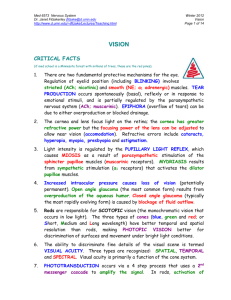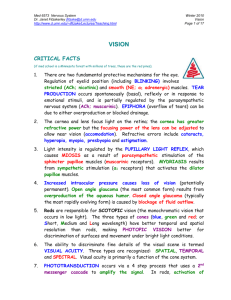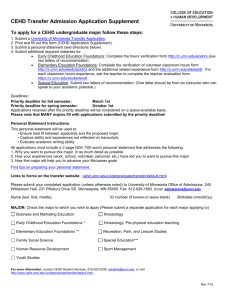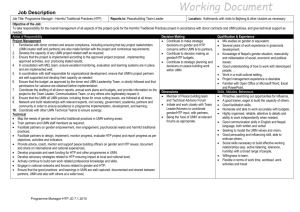vision
advertisement
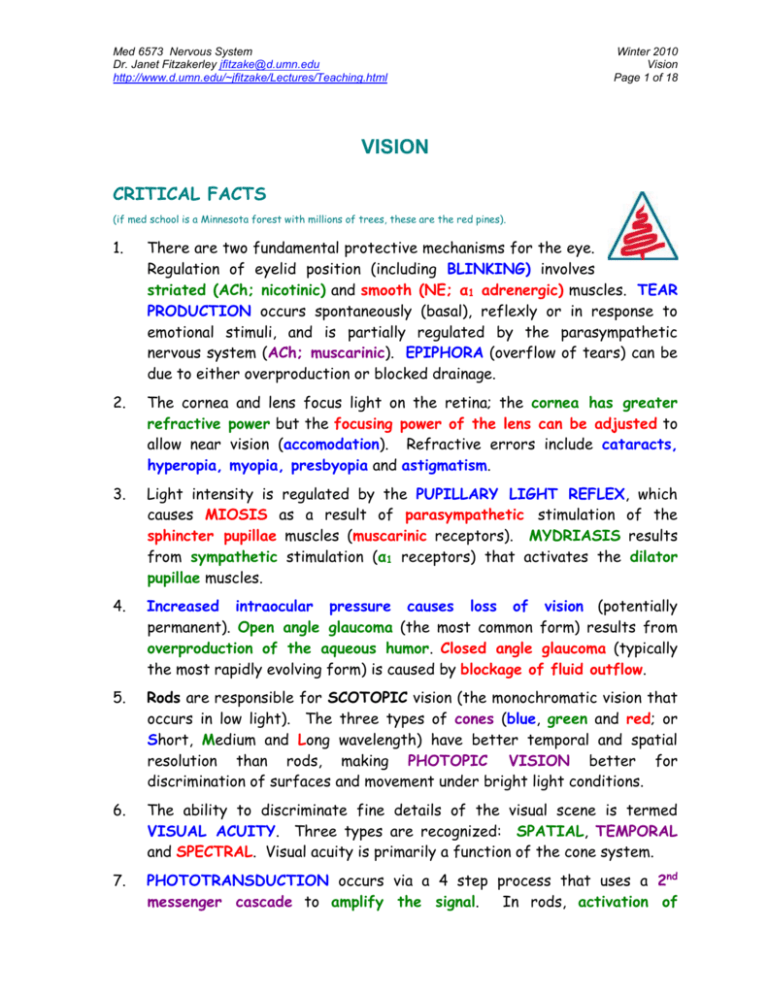
Med 6573 Nervous System Dr. Janet Fitzakerley jfitzake@d.umn.edu http://www.d.umn.edu/~jfitzake/Lectures/Teaching.html Winter 2010 Vision Page 1 of 18 VISION CRITICAL FACTS (if med school is a Minnesota forest with millions of trees, these are the red pines). 1. There are two fundamental protective mechanisms for the eye. Regulation of eyelid position (including BLINKING) involves striated (ACh; nicotinic) and smooth (NE; α1 adrenergic) muscles. TEAR PRODUCTION occurs spontaneously (basal), reflexly or in response to emotional stimuli, and is partially regulated by the parasympathetic nervous system (ACh; muscarinic). EPIPHORA (overflow of tears) can be due to either overproduction or blocked drainage. 2. The cornea and lens focus light on the retina; the cornea has greater refractive power but the focusing power of the lens can be adjusted to allow near vision (accomodation). Refractive errors include cataracts, hyperopia, myopia, presbyopia and astigmatism. 3. Light intensity is regulated by the PUPILLARY LIGHT REFLEX, which causes MIOSIS as a result of parasympathetic stimulation of the sphincter pupillae muscles (muscarinic receptors). MYDRIASIS results from sympathetic stimulation (α1 receptors) that activates the dilator pupillae muscles. 4. Increased intraocular pressure causes loss of vision (potentially permanent). Open angle glaucoma (the most common form) results from overproduction of the aqueous humor. Closed angle glaucoma (typically the most rapidly evolving form) is caused by blockage of fluid outflow. 5. Rods are responsible for SCOTOPIC vision (the monochromatic vision that occurs in low light). The three types of cones (blue, green and red; or Short, Medium and Long wavelength) have better temporal and spatial resolution than rods, making PHOTOPIC VISION better for discrimination of surfaces and movement under bright light conditions. 6. The ability to discriminate fine details of the visual scene is termed VISUAL ACUITY. Three types are recognized: SPATIAL, TEMPORAL and SPECTRAL. Visual acuity is primarily a function of the cone system. 7. PHOTOTRANSDUCTION occurs via a 4 step process that uses a 2nd messenger cascade to amplify the signal. In rods, activation of Med 6573 Nervous System Dr. Janet Fitzakerley jfitzake@d.umn.edu http://www.d.umn.edu/~jfitzake/Lectures/Teaching.html Winter 2010 Vision Page 2 of 18 rhodopsin ultimately results in the closure of cyclic nucleotide gated Na+ channels, and hyperpolarization of the photoreceptor. 8. The VISUAL CYCLE consists of bleaching and recycling of 11-cis-retinol between the photoreceptors and the retinal pigment epithelium (RPE). It is a key component of dark adaptation in rods and is disrupted in vitamin A deficiency, and macular degeneration. 9. Ganglion cells (GCs) are like CNS neurons, in that their contrast-detecting capabilities are enhanced by lateral inhibition provided by amacrine cells. On-center GCs produce more action potentials when stimulated by a bright light in the center of their receptive field, and inhibited by stimuli delivered to the surround. Off-center GCs are stimulated by surround stimuli, and inhibited by center stimuli. 10. Perception of colour is a learned process which involves associating patterns of photoreceptor activity with a particular hue. Even though the distribution of cones within the retina is unique to each individual, the description of hue is standardized by teaching people to associate specific words with their unique pattern of cone response. 11. Within primary visual cortex (V1), inputs from the fovea are overrepresented relative to the periphery. The separate maps that are established for each visual field in primary V1 are merged to form a single perceptual map of visual space. Due to OCULAR DOMINANCE, cortical can extract depth cues based on the disparity in the images, providing the basis for STEREOPSIS (depth perception). 12. STRABISMUS is a muscle imbalance that results in a misalignment of the visual axes of the two eyes. Any type of strabismus that occurs after ~6 months of age causes DIPLOPIA (perception of a single object as double) because the images fall on noncorresponding parts of the retinas. In young children, suppression of the image in the weaker eye can cause a permanent decrease in visual acuity (AMBLYOPIA). ESSENTIAL MATERIAL FROM OTHER LECTURES 1. Structure of the eyeball, including the innervation of the levator palpebrae superioris and superior tarsal muscle, the lacrimal gland, the cornea and the lens (Dr. Severson, Applied Anatomy) 2. CSF formation (Dr. Drewes, Nervous System) Med 6573 Nervous System Dr. Janet Fitzakerley jfitzake@d.umn.edu http://www.d.umn.edu/~jfitzake/Lectures/Teaching.html Winter 2010 Vision Page 3 of 18 3. Pupillary reflex/innervation of the dilator and constrictor muscles of the pupil (Dr. Forbes, Nervous System) 4. Anatomical structures associated with aqueous humor formation and flow, including the ciliary body and the canal of Schlemm (Dr. Severson, Applied Anatomy). 5. Histology of the retina (Dr. Downing, Nervous System). 6. Receptor potentials and lateral inhibition (Dr. Fitzakerley, Nervous System) 7. Visual Fields (Dr. Forbes, Nervous System) LEARNING OBJECTIVES 1. 2. 3. 4. 5. 6. 7. 8. 9. Be able to describe the neurotransmitters involved in eyelid movements, and characterize the purpose and types of blinking. Explain tear production and how it is regulated. Explain the processes of refraction and accomodation as they apply to transmission of light to the retina. Define the following refractive errors: cataracts, hyperopia, myopia, presbyopia and astigmatism. Describe the processes of mydriasis and miosis, including the neurotransmitters involved. Explain how the aqueous humor is formed and drains, and outline control mechanisms for each part of the process. Detail the differences between closed angle and open angle glaucoma. Compare and contrast the physiology of rods and cones. Relate the physiological differences between rods to the different forms of visual acuity. Differentiate between retinopathy and retinitis pigmentosa. List the steps in phototransduction, including the properties of the receptor potential. Describe the visual cycle, and understand the perturbations that occur to this process during vitamin A deficiency and macular degeneration. Outline how lateral inhibition contributes to the receptive field properties of ganglion cells. Describe the function of bipolar, horizontal and amacrine cells. Explain how the primary visual cortex processes color and motion, and generates depth perception. Describe how amblyopia develops from stabismus and diplopia. Med 6573 Nervous System Dr. Janet Fitzakerley jfitzake@d.umn.edu http://www.d.umn.edu/~jfitzake/Lectures/Teaching.html Winter 2010 Vision Page 4 of 18 OPTICS Protective Mechanisms There are two fundamental protective mechanisms for the eye. Regulation of eyelid position (including BLINKING) involves striated (ACh; nicotinic) and smooth (NE; α1 adrenergic) muscles. TEAR PRODUCTION occurs spontaneously (basal), reflexly or in response to emotional stimuli, and is partially regulated by the parasympathetic nervous system (ACh; muscarinic). EPIPHORA (overflow of tears) can be due to either overproduction or blocked drainage. Blinking eyelid movements are mediated by the orbicularis oculi (OO) and levator palpebrae superioris (LPS) muscles, as well as by the superior tarsal muscle (ST) o OO and LPS are striated muscles (ACh acts on nicotinic receptors to cause contraction) o the superior tarsal muscle is a smooth muscle (sympathetic innervation via α1 receptors) three types of motions: 1. maintaining ocular opening tonic activation of LPS and ST; inactivation OO 2. gentle opening/closing, adjustment to changes in globe position activation/inactivation of LPS; inactivation OO 3. blinking, firm closure of eyes OO activation; inhibition of LPS blinking serves a number of functions, including: o corneal lubrication o eye protection o visual information processing Med 6573 Nervous System Dr. Janet Fitzakerley jfitzake@d.umn.edu http://www.d.umn.edu/~jfitzake/Lectures/Teaching.html Winter 2010 Vision Page 5 of 18 blinking can be spontaneous or reflex o spontaneous blinking: is precisely conjugated, periodic, symmetrical, brief and occurs in the absence of external stimuli or internal effort show a wide variation in rate (typically 10-20 blinks/minute in adults; lower in children) originates in premotor brainstem structures that are highly influenced by dopaminergic activity decreased in Parkinson's disease, and increased in schizophrenia and Huntington's disease, for example o the blink reflex: can be initiated by either touch to the cornea (afferents in the trigeminal nerve) or by bright light/rapidly approaching objects (afferents in the optic nerve) is faster than spontaneous blinking Tear Production the tear film that covers the suface of the eye has 3 layers: 1. lipid secred by oil glands in the eyelids 2. aqueous-based solution from lacrimal gland (contains lysozyme and other enzymes that provide protection against infection) 3. mucous from the conjunctiva the composition of the tear layer varies depending upon the stimulus and with age o emotional tears contain more hormones, such as prolactin, ACTH and enkephalin o basal tear production decreases with age tear flow occurs via evaporation and drainage through the nasolacrimal ducts into the nasal cavity o parasympathetic stimulation produces epiphora (overflow of tears) by: 1. increasing tear production by the lacrimal gland 2. decreasing outflow by facilitating closure of the lacrimal duct passage o epiphora can be induced by: 1. stimulation of the cornea (cranial nerve V) which produces reflex tears Med 6573 Nervous System Dr. Janet Fitzakerley jfitzake@d.umn.edu http://www.d.umn.edu/~jfitzake/Lectures/Teaching.html Winter 2010 Vision Page 6 of 18 2. strong emotional responses (mediated by the limbic system, especially the hypothalamus) which produce psychic tears (crying or weeping) strong parasympathetic stimulation is accompanied by other symptoms, like reddening of the face and convulsive breathing Focusing The cornea and lens focus light on the retina; the cornea has greater refractive power but the focusing power of the lens can be adjusted to allow near vision (accomodation). Refractive errors include cataracts, hyperopia, myopia, presbyopia and astigmatism. Refraction Med 6573 Nervous System Dr. Janet Fitzakerley jfitzake@d.umn.edu http://www.d.umn.edu/~jfitzake/Lectures/Teaching.html Accomodation Winter 2010 Vision Page 7 of 18 Med 6573 Nervous System Dr. Janet Fitzakerley jfitzake@d.umn.edu http://www.d.umn.edu/~jfitzake/Lectures/Teaching.html Winter 2010 Vision Page 8 of 18 Refractive Errors Regulation of Light Intensity Light intensity is regulated by the PUPILLARY LIGHT REFLEX, which causes MIOSIS as a result of parasympathetic stimulation of the sphincter pupillae muscles (muscarinic receptors). MYDRIASIS results from sympathetic stimulation (α1 receptors) that activates the dilator pupillae muscles. Med 6573 Nervous System Dr. Janet Fitzakerley jfitzake@d.umn.edu http://www.d.umn.edu/~jfitzake/Lectures/Teaching.html Winter 2010 Vision Page 9 of 18 Formation of the Aqueous Humor Increased intraocular pressure causes loss of vision (potentially permanent). Open angle glaucoma (the most common form) results from overproduction of the aqueous humor. Closed angle glaucoma (typically the most rapidly evolving form) is caused by blockage of fluid outflow. Glaucoma Med 6573 Nervous System Dr. Janet Fitzakerley jfitzake@d.umn.edu http://www.d.umn.edu/~jfitzake/Lectures/Teaching.html Winter 2010 Vision Page 10 of 18 PHYSIOLOGY OF THE RETINA Visible Light Photoreceptors Rods are responsible for SCOTOPIC vision (the monochromatic vision that occurs in low light). The three types of cones (blue, green and red; or Short, Medium and Long wavelength) have better temporal and spatial resolution than rods, making PHOTOPIC VISION better for discrimination of surfaces and movement under bright light conditions. Med 6573 Nervous System Dr. Janet Fitzakerley jfitzake@d.umn.edu http://www.d.umn.edu/~jfitzake/Lectures/Teaching.html Amount of photopigment Pigment type Winter 2010 Vision Page 11 of 18 RODS CONES More Less 1 = rhodopsin 3 overlapping patterns of activity for colour (see page 15) Sensitivity High (1 photon if dark adapted) Saturated in daylight Smaller dynamic range Low (multiple photons to activate) Saturate in very intense light Large DR Temporal resolution Low Slow response Responses are integrated High Fast response Less integration Spatial resolution Poor Respond to scattered light Not in fovea large amount of convergence onto bipolar cells Very good Respond to narrow spots of light In fovea little amount of convergence onto bipolar cells Med 6573 Nervous System Dr. Janet Fitzakerley jfitzake@d.umn.edu http://www.d.umn.edu/~jfitzake/Lectures/Teaching.html Winter 2010 Vision Page 12 of 18 Visual Acuity The ability to discriminate fine details of the visual scene is termed VISUAL ACUITY. Three types are recognized: SPATIAL, TEMPORAL and SPECTRAL. Visual acuity is primarily a function of the cone system. Phototransduction PHOTOTRANSDUCTION occurs via a 4 step process that uses a 2nd messenger cascade to amplify the signal. In rods, activation of rhodopsin ultimately results in the closure of cyclic nucleotide gated Na+ channels, and hyperpolarization of the photoreceptor. Med 6573 Nervous System Dr. Janet Fitzakerley jfitzake@d.umn.edu http://www.d.umn.edu/~jfitzake/Lectures/Teaching.html Winter 2010 Vision Page 13 of 18 Receptor Potential Retinosis Pigmentosa Retinopathy Visual Cycle The VISUAL CYCLE consists of bleaching and recycling of 11-cisretinol between the photoreceptors and the retinal pigment epithelium (RPE). It is a key component of dark adaptation in rods and is disrupted in vitamin A deficiency and macular degeneration. Med 6573 Nervous System Dr. Janet Fitzakerley jfitzake@d.umn.edu http://www.d.umn.edu/~jfitzake/Lectures/Teaching.html Vitamin A Deficiency Macular Degeneration Winter 2010 Vision Page 14 of 18 Med 6573 Nervous System Dr. Janet Fitzakerley jfitzake@d.umn.edu http://www.d.umn.edu/~jfitzake/Lectures/Teaching.html Winter 2010 Vision Page 15 of 18 Ganglion Cell Physiology Ganglion cells (GCs) are like CNS neurons, in that their contrastdetecting capabilities are enhanced by lateral inhibition provided by amacrine cells. On-center GCs produce more action potentials when stimulated by a bright light in the center of their receptive field, and inhibited by stimuli delivered to the surround. Off-center GCs are stimulated by surround stimuli, and inhibited by center stimuli. Med 6573 Nervous System Dr. Janet Fitzakerley jfitzake@d.umn.edu http://www.d.umn.edu/~jfitzake/Lectures/Teaching.html Winter 2010 Vision Page 16 of 18 VISUAL CORTEX PHYSIOLOGY Colour Perception Perception of colour is a learned process which involves associating patterns of photoreceptor activity with a particular hue. Even though the distribution of cones within the retina is unique to each individual, the description of hue is standardized by teaching people to associate specific words with their unique pattern of cone response. Med 6573 Nervous System Dr. Janet Fitzakerley jfitzake@d.umn.edu http://www.d.umn.edu/~jfitzake/Lectures/Teaching.html Winter 2010 Vision Page 17 of 18 Edge Perception Topographic Maps Within primary visual cortex (V1), inputs from the fovea are overrepresented relative to the periphery. The separate maps that are established for each visual field in primary V1 are merged to form a single perceptual map of visual space. Due to OCULAR DOMINANCE, cortical can extract depth cues based on the disparity in the images, providing the basis for STEREOPSIS (depth perception). Med 6573 Nervous System Dr. Janet Fitzakerley jfitzake@d.umn.edu http://www.d.umn.edu/~jfitzake/Lectures/Teaching.html Winter 2010 Vision Page 18 of 18 Depth Perception Development STRABISMUS is a muscle imbalance that results in a misalignment of the visual axes of the two eyes. Any type of stabismus that occurs after ~6 months of age causes DIPLOPIA (perception of a single object as double) because the images fall on noncorresponding parts of the retinas. In young children, suppression of the image in the weaker eye can cause a permanent decrease in visual acuity (AMBLYOPIA).
